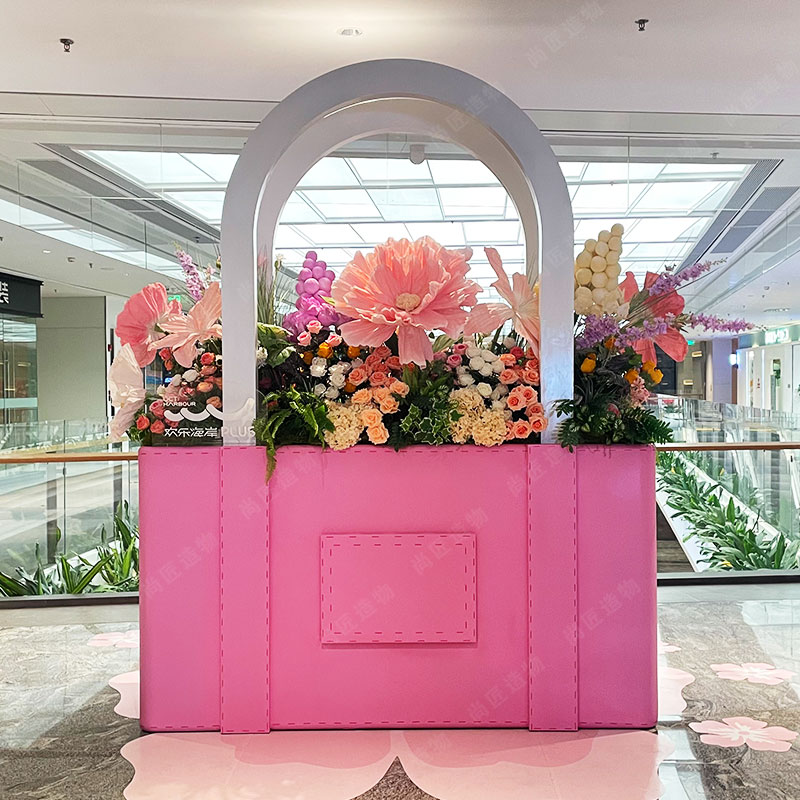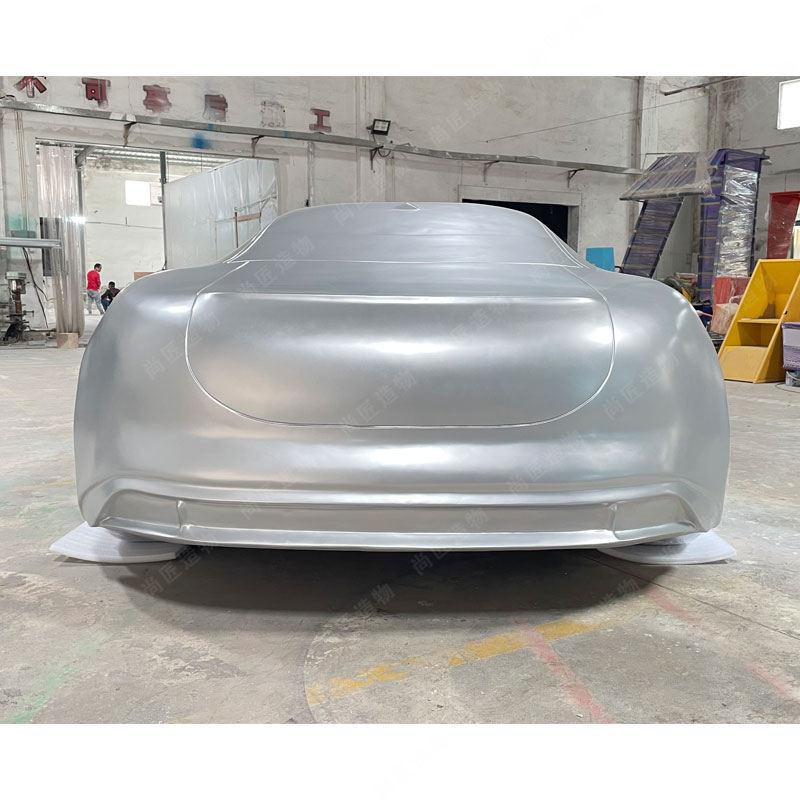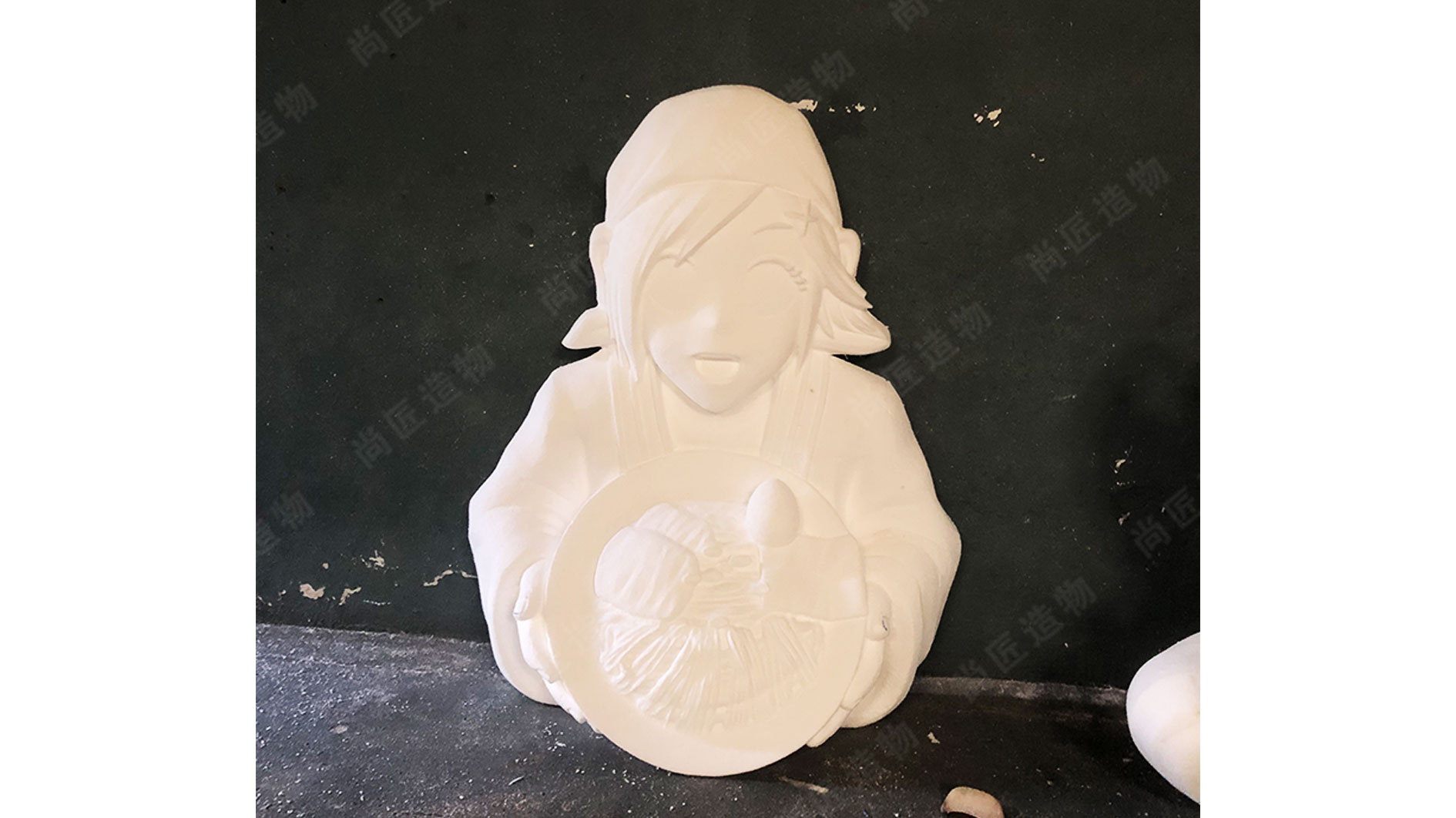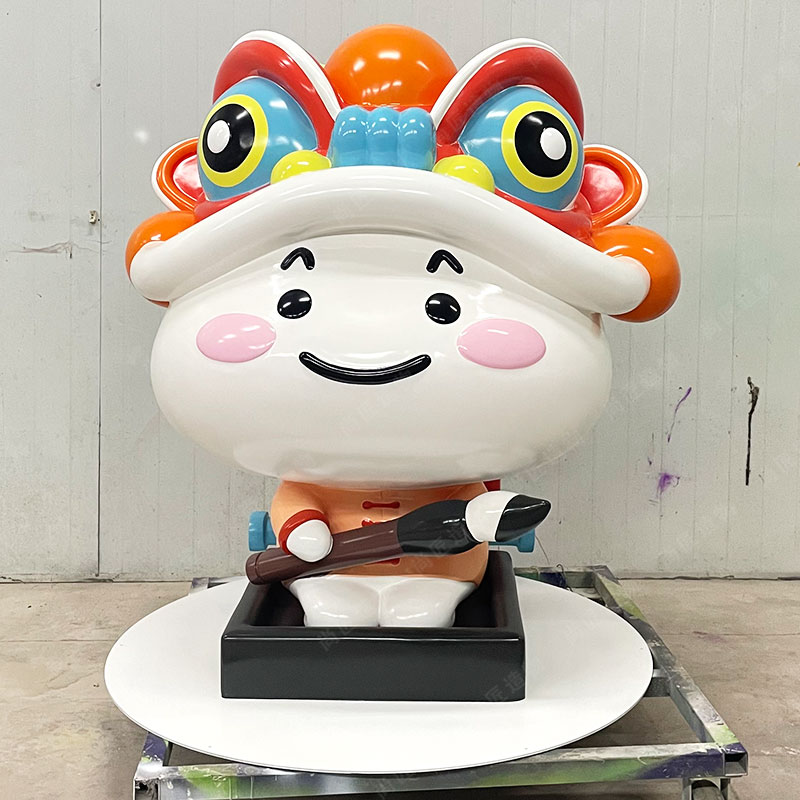Key Takeaways
Fiberglass has become the go-to material for branded mascot sculptures due to its unique combination of durability and versatility. Unlike traditional materials like stone or metal, fiberglass offers a lightweight yet robust structure, making it easier to transport and install in high-traffic areas. Its weather-resistant properties ensure mascots maintain vibrant colors and structural integrity even in harsh outdoor conditions, from heavy rain to prolonged sun exposure.
"Fiberglass allows brands to push creative boundaries without compromising on longevity—a critical balance for public installations."
Customization is another standout feature. Brands can achieve intricate designs, from textured surfaces to dynamic poses, ensuring mascots align perfectly with corporate identity. For businesses seeking reliable solutions, the IP character sculpture line exemplifies how fiberglass merges artistic detail with practical resilience. When selecting materials, consider fiberglass for projects requiring both visual impact and low maintenance. Its adaptability also supports cost-effective updates, such as repainting or adding new elements, to keep mascots relevant as branding evolves.

Fiberglass Benefits in Mascot Design
Fiberglass has become a preferred material for branded mascot sculptures due to its unique combination of durability and adaptability. Unlike traditional materials such as concrete or wood, fiberglass offers high resistance to weathering, UV rays, and physical wear, ensuring mascots retain their visual appeal in outdoor settings for years. Its lightweight nature simplifies transportation and installation, reducing logistical challenges compared to heavier alternatives like stainless steel sculpture.
A key advantage lies in fiberglass’s versatility. Artists can mold it into intricate shapes, enabling precise alignment with brand aesthetics—whether creating sleek modern forms or whimsical characters. The material’s smooth surface also allows for vibrant, long-lasting paint finishes, essential for maintaining brand color consistency.
| Feature | Fiberglass | Steel | Concrete |
|---|---|---|---|
| Weight | Lightweight | Heavy | Very Heavy |
| Durability | High | Moderate | Low |
| Customization | High | Limited | Very Limited |
For brands seeking longevity without compromising design flexibility, fiberglass provides a practical solution. Its structural integrity supports large-scale installations, while modular designs enable easy repairs or updates. This balance of form and function makes it ideal for mascots that serve as both artistic statements and enduring marketing assets.

Durable Outdoor Mascot Materials
Fiberglass has become a cornerstone material for branded mascot sculptures designed to withstand outdoor conditions. Its composite structure—combining glass fibers with resin—creates a robust yet lightweight foundation that resists cracking, fading, and corrosion. Unlike traditional materials like concrete or wood, fiberglass maintains structural integrity under prolonged exposure to UV rays, rain, and temperature fluctuations. This durability ensures mascots retain vibrant colors and sharp details for years, even in high-traffic public spaces.
The material’s adaptability also supports intricate designs, allowing brands to replicate logos, textures, or mascot features with precision. For instance, fiberglass sculpture techniques enable seamless integration of corporate branding elements, from embossed patterns to gradient finishes. Additionally, fiberglass statues require minimal maintenance compared to metal alternatives, which may rust, or foam-based options prone to moisture damage. This balance of resilience and aesthetic flexibility makes fiberglass a practical choice for businesses seeking long-term visibility through outdoor mascots.
Custom Brand Mascots in Fiberglass
Fiberglass has become the go-to material for businesses seeking tailored mascot designs that align with their brand identity. Unlike traditional materials like concrete or metal, fiberglass offers unparalleled flexibility in shaping intricate details—from dynamic poses to lifelike textures—ensuring mascots visually embody a company’s values. This versatility allows brands to translate abstract concepts, such as innovation or reliability, into tangible sculptures that resonate with audiences.
The lightweight nature of fiberglass simplifies logistics, enabling mascots to be easily transported and installed at events, retail spaces, or outdoor venues. Despite its low weight, the material withstands harsh weather conditions, maintaining vibrant colors and structural integrity for years. For example, a realistic sculpture crafted in fiberglass can endure UV exposure, rain, and temperature fluctuations without fading or cracking. Companies often opt for modular designs, allowing parts like removable arms or interchangeable accessories to adapt the mascot for seasonal campaigns or regional promotions.
Advanced molding techniques further enhance customization, enabling precise replication of logos, typography, and even textured finishes mimicking materials like brushed metal or fabric. This adaptability makes fiberglass ideal for brands aiming to create memorable, interactive installations that evolve alongside marketing strategies.

Why Choose Fiberglass for Mascots
Fiberglass has become the material of choice for branded mascot sculptures due to its unique combination of durability and adaptability. Unlike traditional materials like wood or metal, fiberglass resists corrosion, UV damage, and extreme weather conditions, ensuring mascots retain their vibrant colors and structural integrity for years. This weather-resistant quality makes it ideal for outdoor installations, from stadiums to public parks.
The lightweight nature of fiberglass simplifies transportation and installation, reducing logistical challenges compared to heavier alternatives. Despite its low weight, the material maintains remarkable strength, capable of withstanding accidental impacts or harsh environmental stressors. Customization is another key advantage—fiberglass can be molded into intricate shapes, painted with precise brand colors, and scaled to meet specific size requirements. For example, the Cartoon sculpture collection demonstrates how complex designs remain both lightweight and durable.
Brands seeking longevity and visual consistency often opt for fiberglass mascots like the PREMIER SCULPTURE PSF-022, which showcases seamless integration of artistic detail and functional resilience. This combination ensures mascots not only capture attention but also serve as reliable brand ambassadors over time.

Fiberglass Mascots Boost Branding
Fiberglass mascots serve as powerful branding tools by combining visual appeal with functional adaptability. Their lightweight nature allows for effortless transportation and installation at diverse events, from trade shows to public festivals, ensuring consistent brand visibility. Unlike heavier materials, fiberglass’s durability ensures these mascots withstand harsh weather conditions, maintaining their vibrant colors and structural integrity over time. This resilience reduces long-term maintenance costs while preserving the brand’s professional image.
Customization plays a pivotal role in maximizing branding impact. Fiberglass can be molded into intricate shapes, painted in brand-specific hues, or embedded with logos, creating a cohesive visual identity. For example, the Kinetic sculpture demonstrates how dynamic forms in fiberglass capture attention, a principle applied to mascots like PREMIER SCULPTURE’s PSF-022. Such designs foster emotional connections with audiences, turning mascots into memorable symbols of the brand. By blending aesthetics with practicality, fiberglass mascots amplify recognition while supporting scalable marketing strategies across multiple venues.
Lightweight Mascots for Easy Setup
Fiberglass’s low-density composition makes branded mascot sculptures exceptionally lightweight compared to traditional materials like stone or metal. This reduced weight simplifies transportation and installation, allowing businesses to deploy promotional statues in high-traffic areas without heavy machinery or complex logistics. For example, the PREMIER SCULPTURE PSF-022 model weighs approximately 60% less than comparable concrete designs, enabling rapid setup at outdoor events or temporary displays.
The material’s strength-to-weight ratio ensures durability despite its lightness, addressing concerns about stability in windy conditions or high-footfall environments. Modular assembly options further enhance practicality, as larger sculptures can be disassembled into manageable components for storage or repositioning. Retail centers and sports venues frequently leverage this feature to rotate mascots seasonally or align them with marketing campaigns.
While prioritizing ease of handling, fiberglass does not compromise on aesthetic flexibility. Textured finishes and dynamic poses remain achievable, ensuring mascots maintain visual impact even when designed for portability. This balance between functionality and artistry supports brands in maintaining consistent visibility across multiple locations with minimal operational friction.

PSF-022: Premium Fiberglass Mascot
Building on the advantages of fiberglass in mascot design, the PSF-022 model exemplifies how advanced material engineering meets branding needs. Engineered for longevity, this sculpture utilizes layered fiberglass reinforced with resin, achieving a balance between structural integrity and manageable weight. Its core framework resists warping in extreme temperatures, while UV-resistant coatings prevent color fading—critical for outdoor installations facing sun, rain, or snow.
What distinguishes the PSF-022 is its adaptability in customization. Manufacturers employ precision molding techniques to replicate intricate brand elements, from textured logos to dynamic poses, without compromising durability. This approach ensures mascots maintain visual sharpness even after years of exposure. For businesses prioritizing portability, the statue’s modular design allows effortless disassembly, simplifying transportation between events or retail locations.
A practical example includes its use in seasonal campaigns, where brands frequently update mascot accessories or promotional themes. The PSF-022’s surface accepts high-resolution vinyl wraps or paint touch-ups, enabling cost-effective rebranding compared to replacing entire statues. Such flexibility makes it a strategic investment for organizations seeking visibility through consistent, eye-catching displays.
Durable Fiberglass Brand Statues
Fiberglass has become the material of choice for branded statues due to its unique balance of durability and adaptability. Unlike traditional materials like stone or metal, fiberglass resists cracking, rusting, and corrosion, even under prolonged exposure to sunlight, rain, or temperature fluctuations. This weather-resistant quality ensures that mascots and brand symbols retain their vibrant colors and structural integrity for years, making them ideal for outdoor installations in high-traffic areas like storefronts, parks, or event venues.
The strength of fiberglass lies in its layered construction. By combining reinforced plastic with glass fibers, manufacturers create statues that withstand physical stress without sacrificing detail. Brands benefit from this reliability, as sculptures maintain their professional appearance through seasonal changes or accidental impacts. Additionally, fiberglass allows for precise customization—logos, textures, and complex shapes can be molded seamlessly, ensuring alignment with brand guidelines. For example, the PSF-022 model demonstrates how intricate designs, such as layered textures or dynamic poses, remain intact over time.
Lightweight properties further enhance fiberglass’s appeal. Despite their sturdy build, these statues are easy to transport, reposition, or install temporarily for campaigns. This combination of resilience and practicality positions fiberglass as a cost-effective, long-term solution for businesses aiming to elevate their visual identity.
Conclusion
Fiberglass has emerged as the cornerstone material for branded mascot sculptures, combining practicality with artistic flexibility. Its lightweight nature simplifies installation and relocation, while its durability ensures longevity in diverse weather conditions—critical for outdoor branding campaigns. The adaptability of fiberglass allows businesses to translate abstract brand concepts into tangible, three-dimensional forms, creating mascots that resonate with target audiences. Products like the PSF-022 exemplify how advanced fabrication techniques elevate fiberglass into premium artistry, balancing intricate details with structural integrity. As brands increasingly prioritize visual storytelling, fiberglass statues offer a cost-effective solution that marries aesthetic appeal with functional resilience. This material’s role in modern branding underscores its value not just as a medium, but as a strategic tool for fostering memorable brand identities.

Frequently Asked Questions
What makes fiberglass a preferred material for branded mascot sculptures?
Fiberglass combines strength with flexibility, allowing intricate designs while resisting cracks and fading. Its lightweight nature simplifies transportation and installation compared to stone or metal alternatives.
How do weather conditions affect fiberglass mascots?
The material’s resin coating protects against UV rays, rain, and temperature fluctuations. Unlike wood or untreated metals, fiberglass won’t warp, rust, or degrade in outdoor settings.
Can fiberglass sculptures be repainted or modified later?
Yes. Surface treatments enable easy color updates or design adjustments, making it ideal for rebranding. A professional refinishing process ensures longevity without compromising structural integrity.
Are fiberglass mascots suitable for indoor use?
Absolutely. Their lightweight construction reduces floor stress, and smooth surfaces simplify cleaning. Unlike heavier materials, they can be relocated effortlessly for events or layout changes.
What maintenance do fiberglass statues require?
Routine dusting and occasional washing with mild soap suffice. For high-traffic areas, applying protective wax annually helps maintain gloss and prevent minor scratches.
How does the PSF-022 model differ from standard fiberglass options?
PREMIER SCULPTURE PSF-022 uses aerospace-grade resins and reinforced layers, enhancing impact resistance. This premium variant supports finer detailing for logos or textured patterns.
Is fiberglass environmentally safe?
Modern production methods prioritize low-VOC resins, and the material’s durability minimizes replacement waste. Many manufacturers now offer recycling programs for retired sculptures.
 ch
ch English
English






